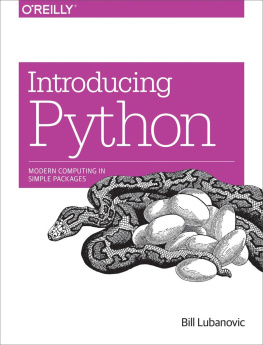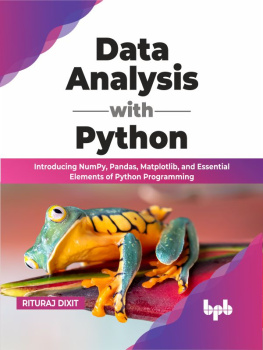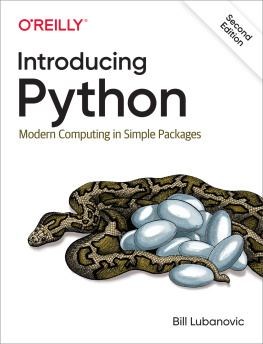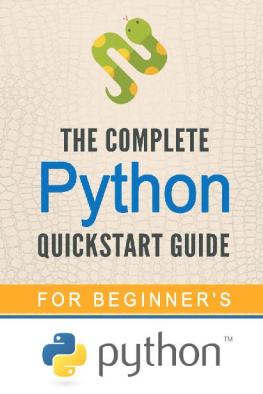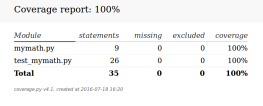Bill Lubanovic - Introducing Python
Here you can read online Bill Lubanovic - Introducing Python full text of the book (entire story) in english for free. Download pdf and epub, get meaning, cover and reviews about this ebook. year: 2018, publisher: OReilly Media, Inc., genre: Home and family. Description of the work, (preface) as well as reviews are available. Best literature library LitArk.com created for fans of good reading and offers a wide selection of genres:
Romance novel
Science fiction
Adventure
Detective
Science
History
Home and family
Prose
Art
Politics
Computer
Non-fiction
Religion
Business
Children
Humor
Choose a favorite category and find really read worthwhile books. Enjoy immersion in the world of imagination, feel the emotions of the characters or learn something new for yourself, make an fascinating discovery.
- Book:Introducing Python
- Author:
- Publisher:OReilly Media, Inc.
- Genre:
- Year:2018
- Rating:5 / 5
- Favourites:Add to favourites
- Your mark:
- 100
- 1
- 2
- 3
- 4
- 5
Introducing Python: summary, description and annotation
We offer to read an annotation, description, summary or preface (depends on what the author of the book "Introducing Python" wrote himself). If you haven't found the necessary information about the book — write in the comments, we will try to find it.
Introducing Python — read online for free the complete book (whole text) full work
Below is the text of the book, divided by pages. System saving the place of the last page read, allows you to conveniently read the book "Introducing Python" online for free, without having to search again every time where you left off. Put a bookmark, and you can go to the page where you finished reading at any time.
Font size:
Interval:
Bookmark:
To Mary, Karin, Tom, and Roxie.
This book will introduce you to thePython programming language.Its aimed at beginning programmers,but even if youve written programs beforeand just want to add Python to your list of languages, Introducing Python will get you started.
Its an unhurried introduction,taking small steps from the basicsto more involved and varied topics.I mix cookbook and tutorial stylesto explain new terms and ideas,but not too many at once.Real Python code is included early and often.
Even though this is an introduction,I include some topics that might seem advanced,such as NoSQL databases and message-passing libraries.I chose these because they can solve some problemsbetter than standard solutions.Youll download and install external Python packages,which is good to know when the batteries included with Pythondont fit your application.And its fun to try something new.
I also include some examples of what not to do,especially if youve programmed in other languagesand try to adapt those styles to Python.And I wont pretend that Python is perfect;Ill show you what to avoid.
Sometimes, Ill include a note such as thiswhen something might be confusing or theresa more appropriate Pythonic way to do it.
This book is for anybody interested in learning what seems to beemerging as the worlds most popular computing language, whether ornot you have learned any programming before.
The first seven chapters explain Pythons basics,and you should read them in order.The later chapters show how Python is used inspecific application areassuch as the Web, databases, networks, and so on;read them in any order you like.The first three appendices showcase Python in thearts, business, and science.Then, you see how to install Python 3 if you dont have it.Next are answers to the end-of-chapter exercises,and then finally, a few cheat sheets of useful things.
Programs are like directions for making socksor grilling potatoes. Some real Python programs give a littledemonstration of the languages look, capabilities,and uses in the real world.Python fares well when compared with other languages,but it has some imperfections.An older version of Python (Python 2) is giving way to a newer one (Python 3).If you have Python 2, install Python 3 on your computer.Use the interactive interpreter to try examples from this book yourself.
This chapter shows Pythons simplest data types:booleans, integers, floating-point numbers, and text strings.You also learn the basic math and text operations.
We step up to Pythons higher-level built-in data structures:lists, tuples, dictionaries, and sets.You use these as you would Legos to build much more complicated structures.You learn how to step through them by using iterators and comprehensions .
In , you weave the data structures of the previous chapters with code structures tocompare, choose, or repeat. You see how to package code in functions and handle errors with exceptions .
This chapter demonstrates how to scale out to larger code structures: modules, packages, and programs.You see where to put code and data, get data in and out, handle options, tour the Python Standard Library,and take a glance at what lies beyond.
If youve done object-oriented programming in other languages,Python is a bit more relaxed. explains when to use objects and classes,and when its better to use modules or even lists and dictionaries.
Learn to manage data like a pro.This chapter is all about text and binary data,the joy of Unicode characters, and I/O.
Data needs to go somewhere.In this chapter, you begin with basic flat files, directories, and filesystems.Then, you see how to handle common file formats such as CSV, JSON, and XML.You also explore how to store and retrieve with relational databases,and even some recent NoSQL data stores.
The Web gets its own chapter, which covers clients, servers, scraping, APIs, and frameworks.In , you work up a real website with request parameters and templates.
This is the hard-core system chapter.In this one, you learn to manage programs, processes, and threads; deal with dates and times; and automate some system administration tasks.
Networking is the subject here: services, protocols, and APIs.Examples range from low-level TCP sockets, to messaging librariesand queuing systems, to cloud deployment.
This chapter contains tips for Python developers, includinginstalling, using IDEs, testing, debugging, logging, source control,and documentation. also helps you to find and install useful third-party packages, package your own code for reuse, and learn where to get more information.Good luck.
The first appendix delves into what people are doing with Python in the arts:graphics, music, animation, and games.
Python has specific applications for business:data visualization (plots, graphs, and maps),security,and regulation.
Python has a strong presence in science:math and statistics, physical science,bioscience, and medicine. featuresNumPy, SciPy, and Pandas.
If you dont already have Python 3 on your computer, this appendix shows you how to install it, no matter if youre running Windows, Mac OS/X, Linux, or Unix.
This has the answers to the end-of-chapter exercises.Dont peek here until youve tried the exercises yourself.
This appendix contains cheat sheets to use as a quick reference.
Computer languages change over time asdevelopers add features and fix mistakes.The examples in this book were written and tested while running Python version 3.3.Version 3.4 was released as this book was being edited, and Ill talk about a few of its additions.If you want to know what was added to Python and when,try the Whats New in Python page.Its a technical reference; a bit heavy when youre just starting with Python,but may be useful in the future if you ever have to get programs to work on computerswith different Python versions.
The following typographical conventions are used in this book:
Constant width Used for program listings, as well as withinparagraphs to refer to program elements such as variables, functions, and data types. Constant width bold Shows commands or other text that should be typed literally by the user. Constant width italic Shows text that should be replaced with user-supplied values or by values determined by context.This icon signifies a tip, suggestion, or general note.
This icon indicates a warning or caution.
The substantial code examples in this bookalthough not the exercises, which are challenges for the readerare available online for you to download. This book is here to help you get your job done. In general, you may use the code in this book in your programs and documentation. You do not need to contact us for permission unless youre reproducing a significant portion of the code. For example, writing a program that uses several chunks of code from this book does not require permission. Selling or distributing a CD-ROM of examples from OReilly books does require permission. Answering a question by citing this book and quoting example code does not require permission. Incorporating a significant amount of example code from this book into your products documentation does require permission.
Font size:
Interval:
Bookmark:
Similar books «Introducing Python»
Look at similar books to Introducing Python. We have selected literature similar in name and meaning in the hope of providing readers with more options to find new, interesting, not yet read works.
Discussion, reviews of the book Introducing Python and just readers' own opinions. Leave your comments, write what you think about the work, its meaning or the main characters. Specify what exactly you liked and what you didn't like, and why you think so.


